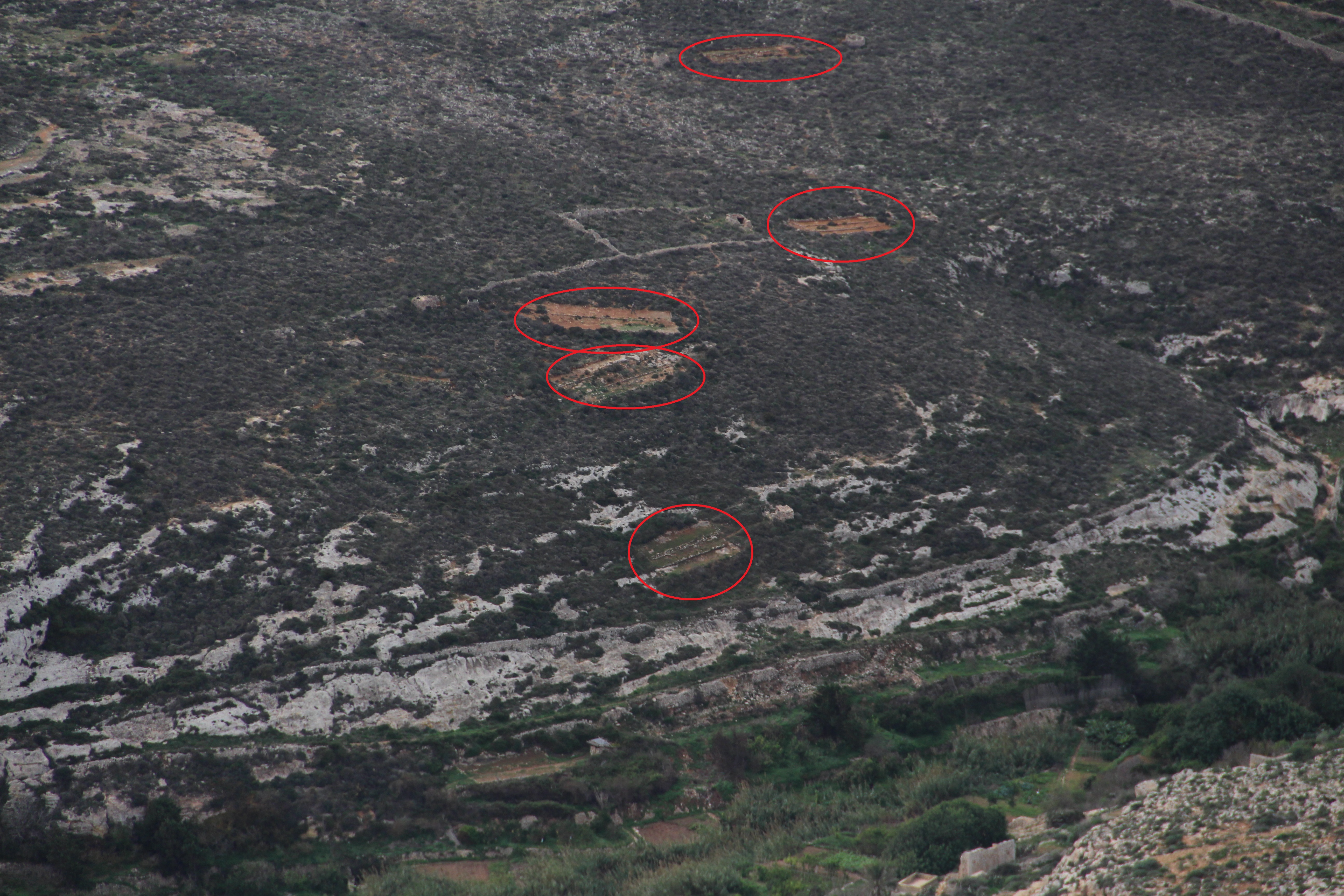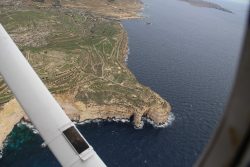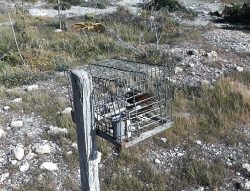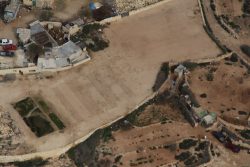
Aerial photograph taken on the 14th November 2016 over the Il-Qortin tal-Magun Special Area of Conservation (Natura 2000), showing four finch trapping sites (circled in red) cleared within priority garigue habitat. The cover photo taken on the same day shows a similar situation over the coastal cliffs of Baħrija, also a designated Natura 2000 site (Photos by BirdLife Malta)
Over a third of trapping sites active during this autumn’s trapping derogation are not registered and illegal, while the remaining sites permitted by the Wild Birds Regulation Unit (WBRU) within Natura 2000 sites are in possible breach of habitat protection regulations.
BirdLife Malta and the Committee Against Bird Slaughter (CABS) are today revealing the results of separate surveys undertaken during the trapping season of 2016, following various reports filed over a number of trapping sites situated across Malta and Gozo to enforcement authorities for action. The results follow an earlier cry by both organisations against the rampant illegal use of electronic bird callers throughout the trapping season.
Standardised surveys were undertaken by means of flights along the coastline, photographing active trapping sites from the air, along coastal cliffs; the major part of which are designated Natura 2000 sites for the important habitats they host. After matching the locations of encountered trapping sites with areas marked as protected habitat by the Environment and Resources Authority (ERA), both BirdLife Malta and CABS filed queries to WBRU expressing doubts over the legality of these sites.
From a total of 106 sites queried by BirdLife Malta, WBRU informed that 49 were not registered (46%). CABS reported separately 73 sites to WBRU, receiving notification of 19 sites not being registered (26%) – the majority of which were found located on protected garigue habitat. This adds up to a total of 68 out of 179 sites being not registered and illegal (38%).
Sites were also reported to the Police and ERA, however sites checked by CABS at the end of November were found to be still active, despite the reports which were filed. BirdLife Malta subsequently alerted ERA to query what enforcement action is being taken on these sites. ERA replied that the matter was being left in the remit of the Malta Police Force. During the last Ornis Committee meeting, WBRU informed that up until the 15th December, police had filed only three prosecutions for the illegal use of trapping sites, while ERA informed it had taken action on a single site in Gozo.
The trapping season runs until the 31st of December. According to the Flora, Fauna and Natural Habitats Regulations which transposed the EU Habitats Directive in Malta, any activities within a Natura 2000 site need a permit. Queries sent to ERA, expressing concerns over the damage to habitats caused by trapping activity within Natura 2000 sites, and asking whether such activities carried the necessary nature permits, have not yet been answered.

The whole area of Ta’ Ċenċ in Gozo is also a Natura 2000 site, and privately owned. Yet trappers have been using these sites throughout the past months, unhindered. (Photo by BirdLife Malta)
Up to 6,351 trapping sites are currently active with the blessing of the WBRU, with each site capable of operating up to two clap nets each if in use by a single person. With a minimum size of 38 square metres afforded for each clap net, the total area across the Maltese Islands covered by nets during the past season is at least 482,676 square metres or 48 hectares. In reality, the areas taken up by trapping sites could be up to 78 hectares considering that an estimated 38% of sites are not even registered (average from BirdLife Malta and CABS estimate). By comparison, this comprises an area of nets laid out in the countryside which is larger than the size of Valletta (55 hectares).
Two trapping seasons are currently open by means of two derogations to the Birds’ Directives. The trapping season for finches for which over 3,132 trappers are registered is currently being challenged by the European Commission at the European Court of Justice. Malta had agreed to phase out the practice by 2009, following which trapping of finches was banned. In 2014, Malta re-opened the season via a derogation, allowing the registration of new trapping licences in the process.
The trapping season for Golden Plover and Song Thrush is permitted by means of a separate derogation for which up to 997 trappers are currently licensed. The trapping season is also subject to an Infringement Procedure, with the Commission issuing two formal warnings between 2011 and 2012, in particular drawing attention to the illegal presence of finch trapping sites across Natura 2000 sites.
Registrations for licences and trapping sites were vetted by WBRU, who would have scrutinised each application on the basis of criteria set in the law (Conservation of Wild Birds Regulations). Applications do not take regard of land ownership, with sites registered over private and public land.
CABS Press Officer Axel Hirschfeld stated: “We have no faith in WBRU to provide adequate enforcement due to lack of technical competence, and conflict of interest since they also open derogation and issue licenses”.
BirdLife Malta Conservation Manager Nicholas Barbara stated: “WBRU have authorised the season without having their enforcement setup capable of dealing with the thousands of trapping licences which the unit itself has authorised. This has led to a lack of strict supervision, with a good proportion of trapping sites being illegal and unregistered and moreover possibly lacking adequate permits to operate within Natura 2000 sites, to the detriment of these areas of ecological importance. The respective enforcement has also been left up to ALE and Gozo Police who are also enforcing the hunting season and which are restricted in their resources. Moreover ERA is seemingly not being asked to intervene by WBRU.”
Both BirdLife Malta and CABS state that this goes to show that there needs to be a central authority with respect to enforcement on environment and not have this division between WBRU and ERA – with one hand consenting trapping sites in ecologically sensitive sites, which the other authority should be vetting and safeguarding. Both trapping derogations are year after year resulting in a vast degradation of priority habitats in Natura 2000 sites, which the authorities appear not being able to enforce or control.
Response to Government statement about illegal use of electronic bird callers
In a reaction to Parliamentary Secretariat for Agriculture, Fisheries and Animal Rights statement that the illegal use of bird callers declined by 60% over pre-2013 levels, issued on the 19th December, BirdLife Malta also stated that Parliamentary Secretary Roderick Galdes is wrong when from the comfort of his office he declares there is a decline in electronic callers because in reality this year electronic callers have been heard across Malta and Gozo at all times including at night. Galdes also jumps to the wrong conclusion when he states there is a decline because there have been less convictions. The decline in convictions only proves the decline in will and resources to have a proper enforcement strategy in place to eradicate illegalities.
The level of detection of these illegalities by government authorities lacks will and manpower. The statement that “it is logistically difficult to locate and dismantle such illegal electronic devices at night” continues to show how powerless enforcement authorities currently are. Accordingly any conclusions on the basis of police convictions do not reflect in any way that these illegalities have been on the decrease.
CABS too states that the drop in convictions only proves that the ALE has become less effective. Deducing a decrease of illegal bird callers based on the number of convictions is like comparing apples with oranges. In fact the number of Golden Plover electronic callers in the countryside and cases of night trapping have multiplied in the last years. “Roderick Galdes is either living in a dream-bubble or he is deliberatly downsizing the problem to distract from the government’s total failure to curb illegal trapping”, concluded Axel Hirschfeld.
Read the Maltese version of the press release here. Click here to watch a video edit with aerial footage showing various trapping sites across Malta and Gozo, most of them in Natura 2000 sites.
Notes:
- The Wild Birds Regulation Unit (WBRU) is the entity in government which reports the application of trapping and hunting derogations to the European Commission, and which accordingly is responsible to see the adequate implementation and enforcement of the derogation conditions.
- The Environment Resources Authority (ERA) is the entity in government responsible for the protection of habitats and Natura 2000 sites across Malta. The authority requests that especially for Natura 2000 sites, any activity is covered by nature permits, which the authority normally scrutinises to ensure that such activities are sustainable and are not damaging to habitats and wildlife within these priority sites.


